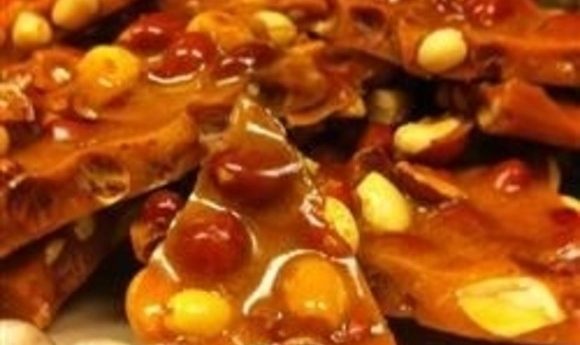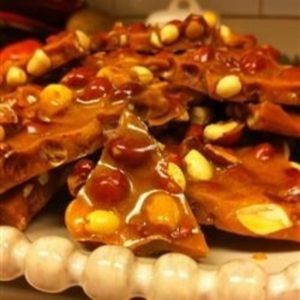Perfecting peanut brittle

Peanut brittle may seem like the simplest holiday treat, but it requires complicated chemistry to perfect.

Nothing characterizes the holiday season like the snap of a good homemade nut brittle or the stretch of a soft caramel. Like many traditions, this is more about grandparents pulling out their candy thermometers and gathering families into the kitchen than it is about the finished toffee or hard candy. But like any successful experiment in the lab, knowing the purpose of every reagent in these candy-making reactions is the key to ensuring a good outcome.
Peanut brittle relies on sugar in its non-crystalline form, so the first step to making it is to break down the disaccharide sucrose (common table sugar) to separate it into the monosaccharides that make it up—fructose and dextrose—which requires acid, water, and heat. As the sugar dissolves in water, the hydrolysis reaction will continue as long as the sugar and acid are in a fluid state, which depends on the amount of water present and how quickly it evaporates. You can control this by watching the temperature closely. For peanut brittle, start with a quantity of water that is 20-50% of the sugar by weight, and heat the solution over high heat.
As the water converts to steam, the monosaccharides begin to saturate the solution, increasing their tendency to form crystals and precipitate, which results in a gritty brittle. To prevent this, you need to interfere with the ability of fructose to rejoin dextrose. Once the solution reaches a boil, stop stirring it, since this can create cool pockets that promote crystallization. At this stage, it helps to add agents that chemically interfere with crystallization such as other monosaccharide sugars or acids. Acids tend to make syrups more prone to browning and more hygroscopic, making them soft and sticky. For brittles, glucose is the best option. Keeping the sides of the pot clean of crystals by brushing it with water can also help avoid crystallization as these crystals may seed crystallization in the solution.
Cooking is complete when the sugar reaches a certain level of saturation, which can be measured using a refractometer. But luckily for those of us who don’t keep a refractometer at home, sugar cooked to a certain temperature will always contain the same percentage of dissolved solids, so we can simply monitor our reactions using a candy thermometer. For peanut brittle, the proper level of saturation occurs at 110oC, which is where you can quickly stir in the peanuts (or substitute sesame seeds, other nuts, or cocoa nibs). Continue cooking, stirring constantly to roast the nuts and further saturate the sugar solution until the mixture reaches 155oC.
While 155oC is actually below the temperature at which sugar caramelizes, the amino acids present in the nuts contribute significantly to the Maillard reaction—a set of chemical reactions that browns everything from roasted squash to seared ribeye steak—speeding up flavor development.
When ready, remove the brittle mixture from the heat and add butter, vanilla extract, and salt to flavor your candy. Baking soda is also very important at this stage since it reacts to the heat, creating carbon dioxide that aerates the caramel, enabling it to snap when someone bites into it rather than requiring them to gnaw at it until it breaks or pulls apart. Baking soda also raises the pH of the mixture, promoting the Maillard reaction and giving the brittle its particular color and flavor profile.
Finally, pour the mixture onto a marble slab or cookie sheet so that it will cool quickly and evenly. You can stretch it as it cools if desired, or simply break it into pieces and serve it after dinner.